Discover 35 hidden attractions, cool sights, and unusual things to do in Rostock (Germany). Don't miss out on these must-see attractions: Doberan Minster, Warnemünde, and Petrikirche. Also, be sure to include Güstrow Palace in your itinerary.
Below, you can find the list of the most amazing places you should visit in Rostock (Mecklenburg-West Pomerania).
Table of Contents
Doberan Minster
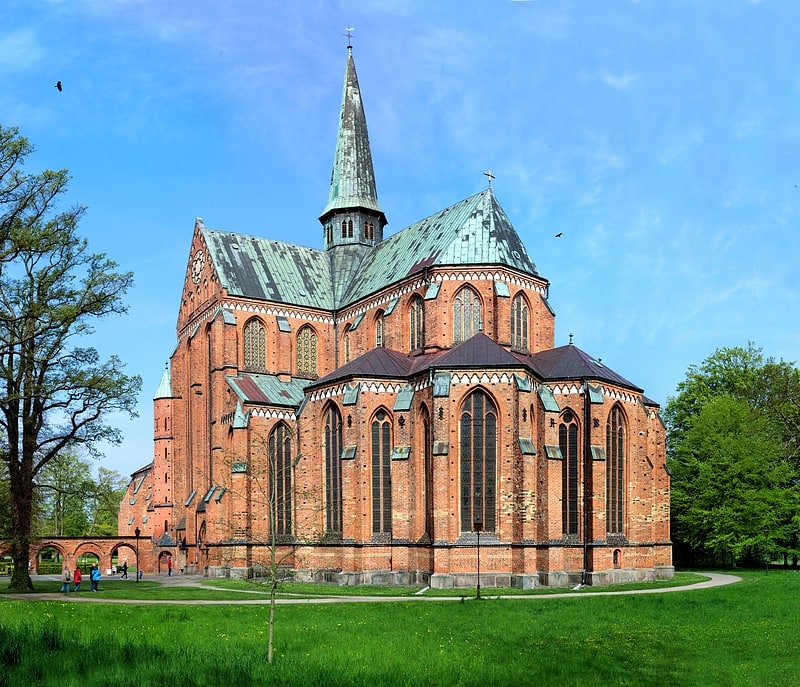
Also known as: Doberaner Münster
Church in a 14th-century monastery. The Doberan Minster is the main Lutheran Church of Bad Doberan in Mecklenburg, Germany. Close to the Baltic Sea and the Hanseatic city of Rostock, it is the most important religious heritage of the European Route of Brick Gothic. It is the remaining part of the Ex-Cistercian Doberan Abbey, dedicated in 1368. The first abbey in Mecklenburg, founded in 1171, which was also used as the burial site for the regional rulers, became important both politically and historically.
Through the activities of its inhabitants, the abbey greatly contributed to the cultural and economic development of Mecklenburg and became the centre of Christianity in this region. No other Cistercian abbey in Europe can lay claim to such a large amount of the original interior remaining intact. Among the treasures are the main altar which is the oldest winged altar in art history, the monumental cross altar and the sculpted tomb of Danish Queen Margarete Sambiria. Even after the reformation and the dissolution of the abbey in 1552, the church continued to serve as the main burial place for the ruling Mecklenburg nobility as well as the place of worship for the Evangelical-Lutheran congregation. The Minster in Bad Doberan is said to be the most important medieval building in Mecklenburg-Vorpommern, the best example of medieval creativity put in practice and it is a building of the highest technical and artistic perfection. The furnishings on display are of highest artistic quality. No other church in northern Germany has such complete and historically important liturgical furnishings. The mostly well preserved Cistercian furnishings are unique. The abbey is a unique and precious artistic monument in the coastal region of the Baltic Sea.[1]
Address: Klosterstraße 2, 18209 Bad Doberan
Warnemünde
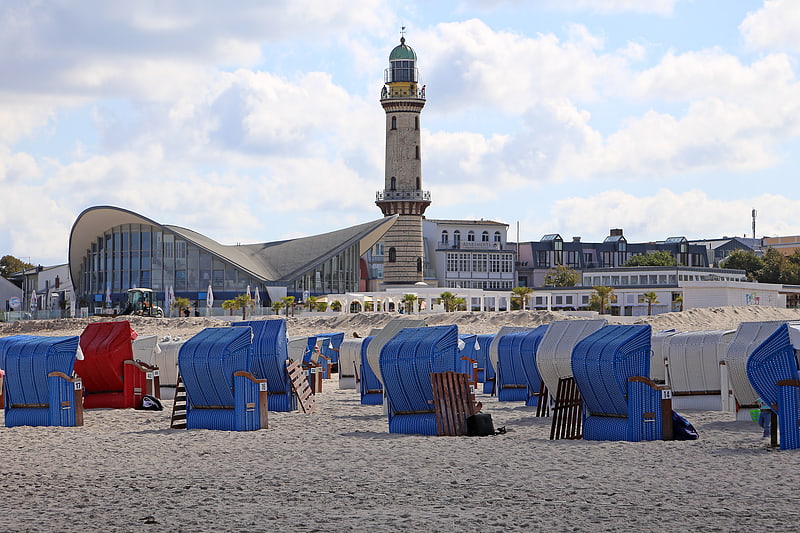
Lighthouse in Rostock, Germany. Warnemünde Lighthouse is a lighthouse situated on the Unterwarnow, the estuary of the Warnow river, in Warnemünde, a district in the city of Rostock. The lighthouse has a height of 36.9 metres and was put into service in 1898.[2]
Address: Am Leuchtturm, 18111 Warnemunde (Ortsamt 1)
Petrikirche
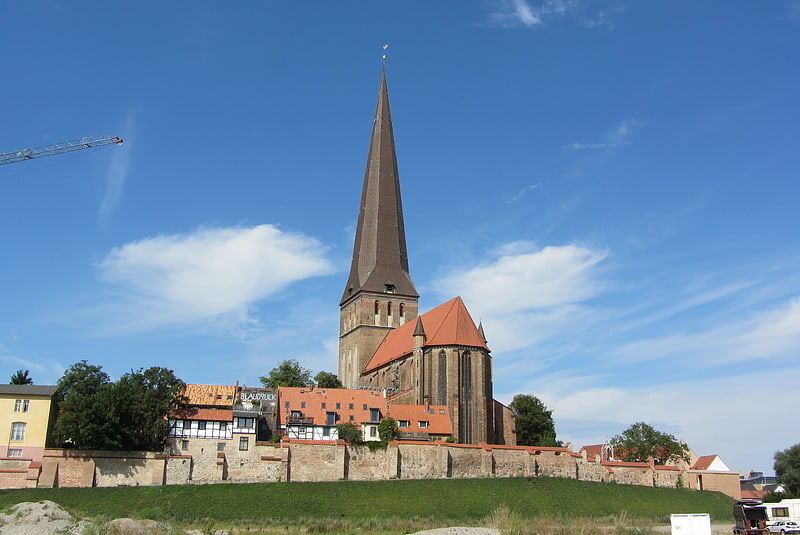
Evangelical church in Rostock, Germany. St. Peter's Church, in German Petrikirche, was built in the 13th century and is the oldest of three town churches found in the Hanseatic city of Rostock, in northern Germany. The other two are St. Mary's Church and St. Nicholas . A fourth, St. Jakobi, was heavily damaged during the Second World War and subsequently demolished.[3]
Address: Alter Markt, 18055 Rostock (Ortsamt 6)
Güstrow Palace
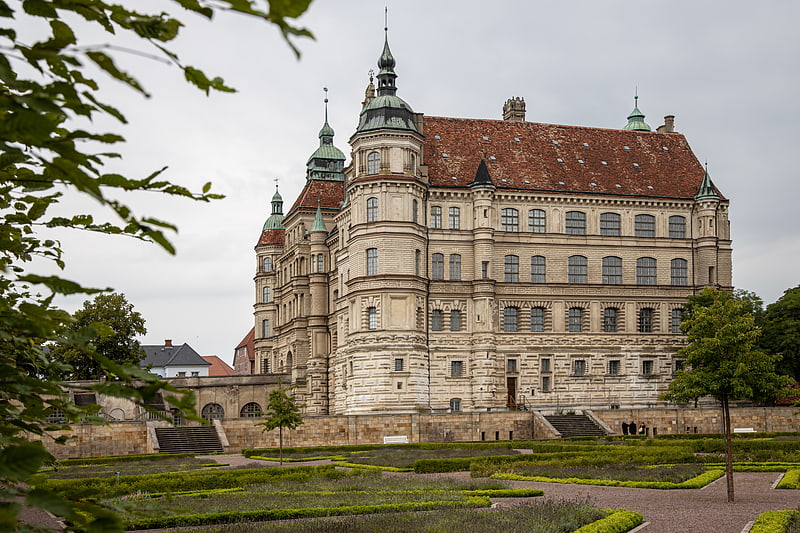
Also known as: Schloss Güstrow
Castle in Güstrow, Germany. Güstrow Palace is a Renaissance-era palatial schloss in Güstrow, Mecklenburg-Western Pomerania, Germany, used as a museum and cultural centre.
Built in 1558 for Ulrich, Duke of Mecklenburg, it is located close to the town wall of Güstrow's old town, and is quadrangular in shape. The 16th-century palace features stucco decorations and a Baroque-classicist gatehouse.[4]
Address: Franz-Parr-Platz 1, 18273 Guestrow
Rostocker Yachtclub e.V.
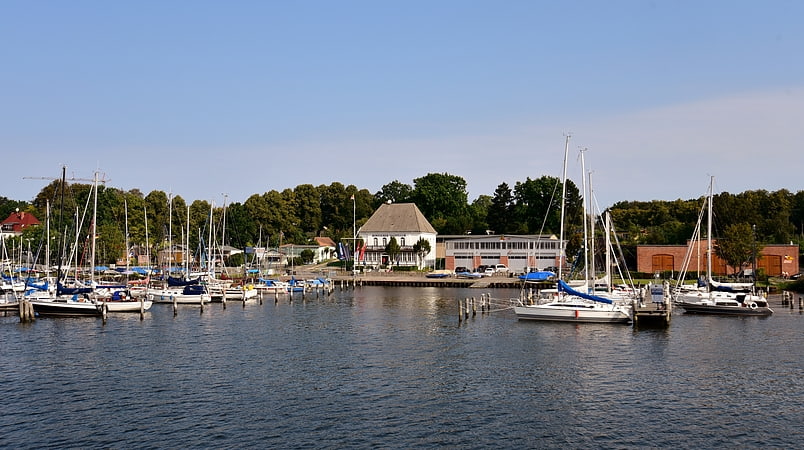
Sailing, Marina
Address: 5 Uferpromenade, Rostock (Ortsamt 8)
Rostock Zoo

Also known as: Zoo Rostock
Zoo in Rostock, Germany. Rostock Zoo is a zoo in the city of Rostock, founded in 1899. It covers 56 hectares and with 4,500 animals from 320 species, Rostock Zoo is the largest zoo on the German east coast. Rostock Zoo is studbook keeper of Polar bears within the European Endangered Species Programme. The director of Rostock Zoo is Udo Nagel.[5]
Address: Barnstorfer Ring 1, 18059 Rostock (Ortsamt 5)
Baltic Sea watchtower

Also known as: Ostsee-Grenzturm Kühlungsborn
The Baltic Sea watchtower in Kühlungsborn is an old East German border troops watchtower that was manned by the Coastal Brigade or GBK. As a maritime observation town of type BT 11 it was one of a series of originally 27 towers of this type on the coast of East Germany, of which only two survive.[6]
Address: Ostseeallee 1A, 18225 Kühlungsborn
Kunsthalle Rostock
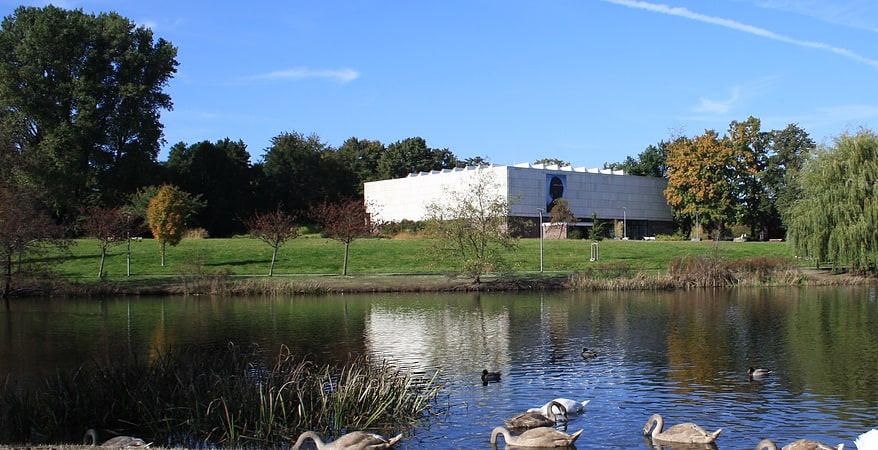
Museum in Rostock, Germany. The Rostock Art Gallery was opened on 15 May 1969 as a museum of contemporary art in Rostock in the German federal state of Mecklenburg-Vorpommern. It is in the grounds of the park around the Schwanenteich lake in the quarter of Reutershagen.[7]
Address: Hamburger Str. 40, 18069 Rostock (Ortsamt 5)
Marienkirche
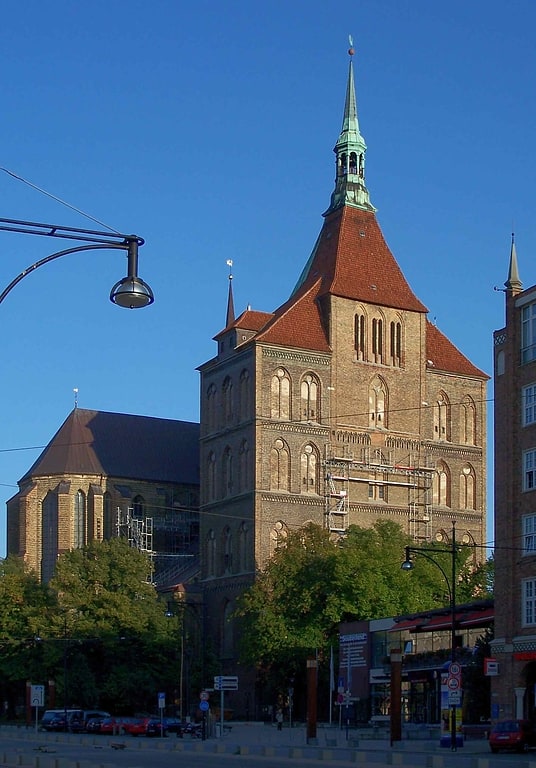
1265 church with an ornate wooden altar. St. Mary's Church, Rostock, in German Marienkirche, is the biggest of three town churches found in the Hanseatic city of Rostock, in northern Germany. The other two are St. Peter's and St. Nicholas . A fourth, St. James', was heavily damaged during the Second World War and subsequently demolished. St. Mary's was designated in 1265 as the main parish church. Since the Protestant Reformation in 1531, it houses a congregation of the Evangelical Lutheran State Church of Mecklenburg.[8]
Address: Am Ziegenmarkt 4, 18055 Rostock (Ortsamt 6)
Zoological Collection Rostock

Museum in Rostock, Germany. The Zoological Collection Rostock is a scientific university collection and associated with the zoological department of the University of Rostock, Germany. The collection was founded in 1775 by Oluf Gerhard Tychsen and is used both for teaching and research. Parts of the collection are open to the public.[9]
Ostseestadion

Stadium in Rostock, Germany. The Ostseestadion is the home stadium of FC Hansa Rostock, a German association football club, located in the city of Rostock. It has a capacity of 29,000.
"Ostseestadion" translates in English to "Baltic Sea Stadium", and is named after the Baltic Sea, whose coast Rostock lies upon. Ostseestadion is the original name of the stadium, but on 2 July 2007, Hansa Rostock sold the naming rights for the following 10 years to Deutsche Kreditbank (DKB), hence the new official name became "DKB Arena". In 2015, the club announced that the stadium was to regain its original name, and that the DKB had allowed an early renaming of the stadium and agreed to end the naming contract in advance.[10]
Address: Kopernikusstr. 17, 18057 Rostock (Ortsamt 5)
Warnemünde Church
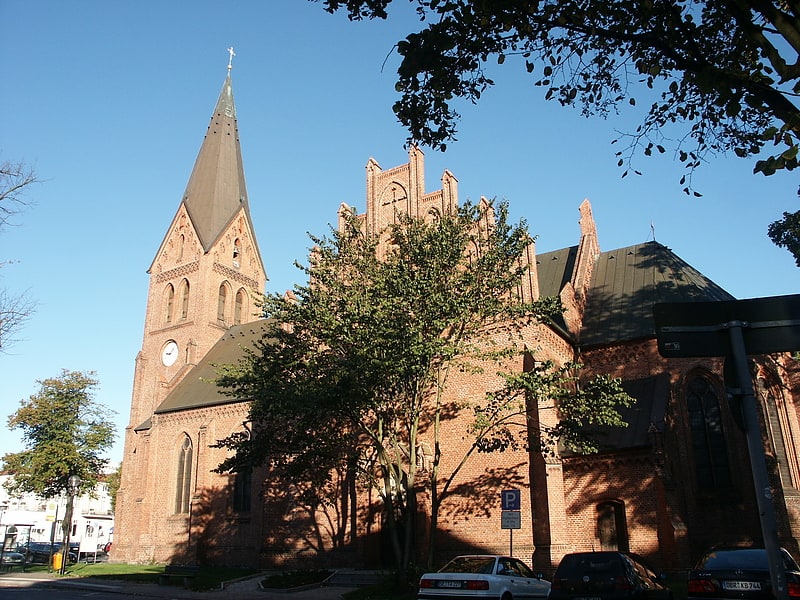
Also known as: Kirche Warnemünde
Evangelical church in Rostock, Germany. Warnemünde Church is a neogothic building in Warnemünde, which is a part of the hanseatic city of Rostock. Construction of the current brick building began in 1866 and the church was consecrated in 1871. The church of Warnemünde stands for over one hundred years in the middle of the town and is the center of the Evangelical Lutheran congregation. For the community along with many guests it is a place of rest and prayer. But it has also even given protection from flooding. The maritime atmosphere is shown by the special votive ships inside.[11]
Address: Kirchenstr. 1, 18119 Warnemunde (Ortsamt 1)
Kamp
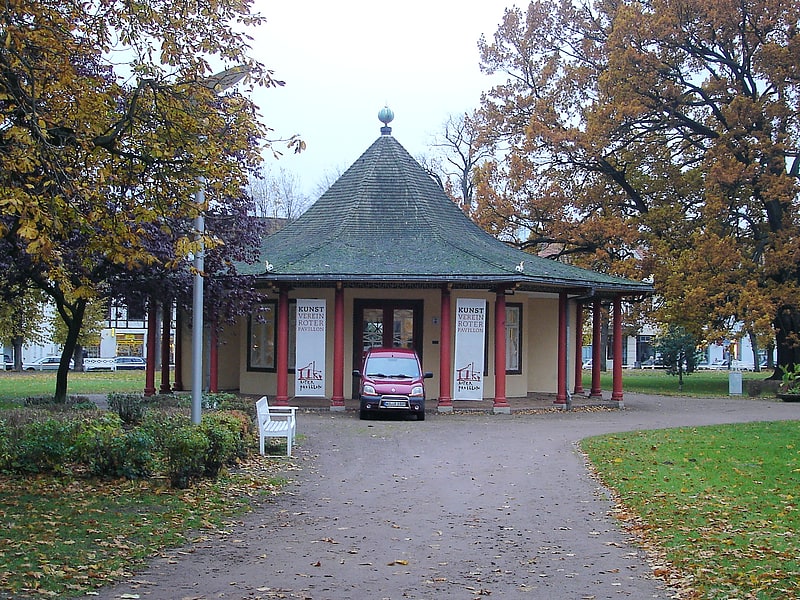
State park in Bad Doberan, Germany. The Kamp is a triangular, lime-fringed park, about two hectares in area, which was laid out in 1800 in the centre of the small German town of Bad Doberan. In the 19th century, the Kamp was the social hub of the Doberan, because it was surrounded by the most prestigious buildings in the town.[12]
Address: Am Kamp, Rostock
Kloster zum Heiligen Kreuz
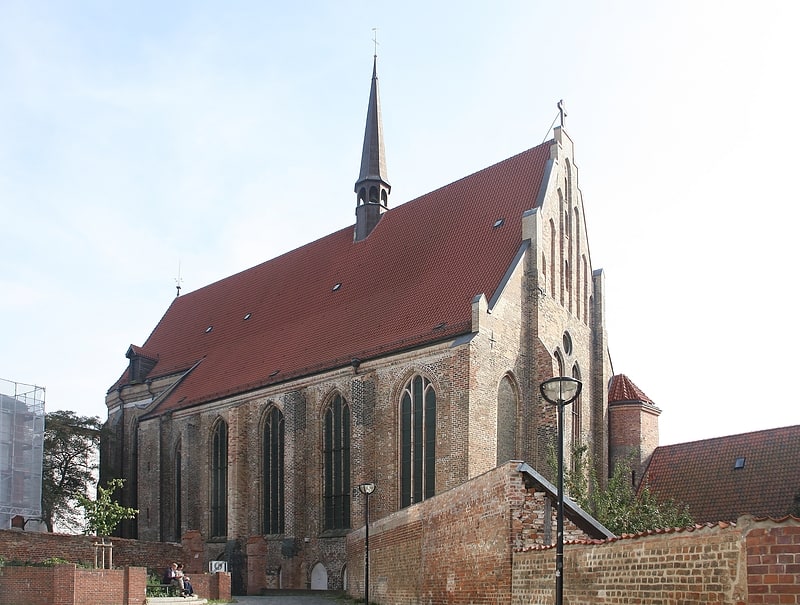
Museum in Rostock, Germany. The Abbey of the Holy Cross in Rostock, Germany, was founded in the 13th century by Cistercian nuns. It is the only fully preserved abbey in the city. The complex includes the former abbey church which is used today as the University Church. The remaining former convent buildings house the Museum of Cultural History for the city of Rostock.[13]
Address: Klosterhof 7, 18055 Rostock (Ortsamt 6)
Dom zu Güstrow

Also known as: Güstrower Dom
Evangelical church in Güstrow, Germany. The "Dom" is a Brick Gothic Lutheran church, the largest church in the German city of Güstrow. Historically it has been built as a collegiate church. It has never been a cathedral. Initially completed in 1335, the church is the oldest extant building in Güstrow. It houses the sculpture Der Schwebende, a war memorial created by Ernst Barlach.[14]
Address: Dompl. 4, 18273 Güstrow
Rostock Port
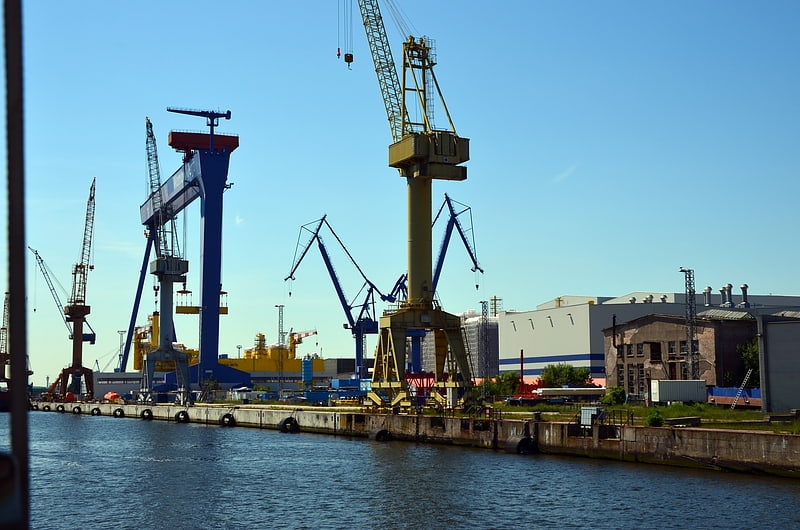
Rostock Port is a large German port on the Baltic Sea, it is located on the Unterwarnow estuary in the city of Rostock. Most of the port infrastructure is owned by Rostock Port GmbH, a joint venture between the state of Mecklenburg-Vorpommern and the Hanseatic City of Rostock. The port operations are carried out by Euroports Germany GmbH & Co. and other private companies. With a total throughput of 28.8 million tons, the ports of Rostock is the fourth largest German port.
The ports of Rostock include the Rostock seaport located on the east side of the Unterwarnow (built since the 1960s), the chemical port for Yara located east of it at Breitling, the independent freight and fishing port (RFH) in the west side of the Unterwarnow, the cruise terminal at the passenger quay in Warnemünde and other smaller facilities such as the Maritime Industrial Park (MAGEB) and the Quay of Alba Nord north of the RFH and the Rostock city port, where goods are handled no more.[15]
Max Planck Institute for Demographic Research
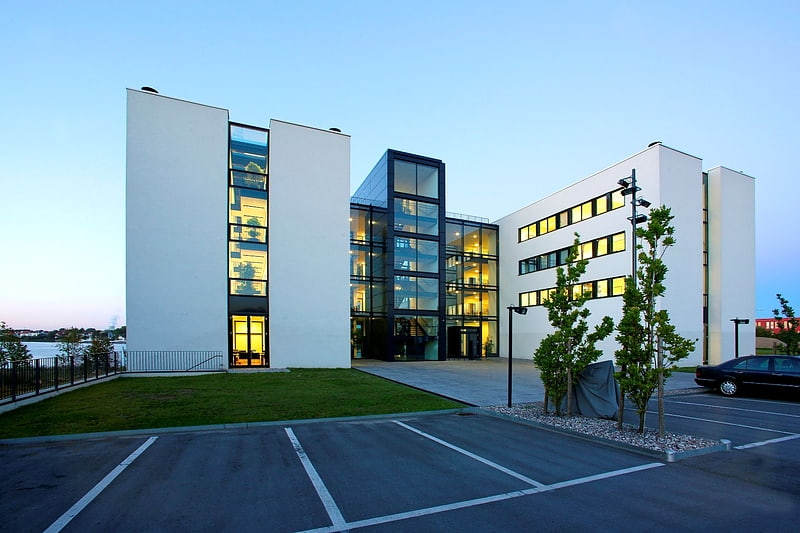
Research institute in Rostock, Germany. The Max Planck Institute for Demographic Research is located in Rostock, Germany. It was founded in 1996 by James Vaupel and moved into new buildings in Rostock in 2002. It is one of approximately 80 institutes of the Max Planck Society.
The MPIDR is jointly led by Emilio Zagheni, who took over from MPIDR founding director James Vaupel in February 2018, and Mikko Myrskylä. Myrskylä replaced Joshua R. Goldstein in 2014, who had taken over from Jan Hoem.[16]
Stadthafen Rostock
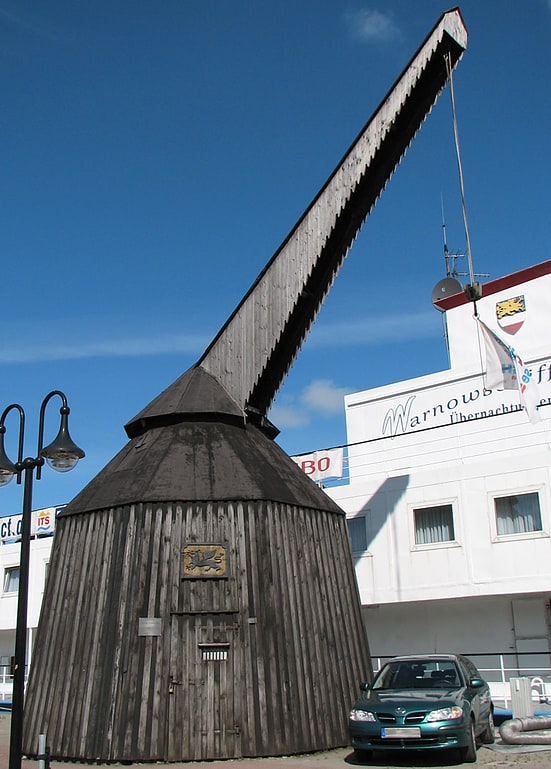
Rostock City Harbor is the part of the harbor located on the southern bank of the Lower Warnow River north of the historic Old Town of the Hanseatic City of Rostock.
Address: Stadthafen Rostock, Rostock (Ortsamt 6)
Botanischer Garten Universität Rostock
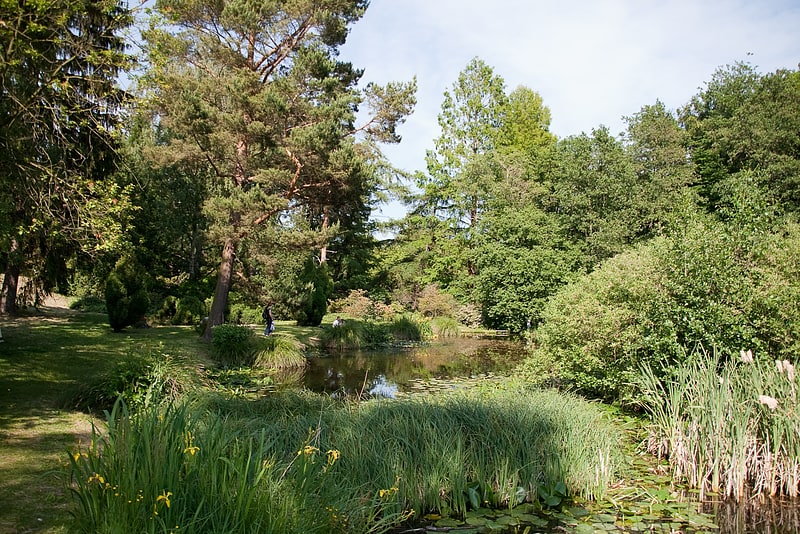
Also known as: Botanischer Garten
University garden and greenhouses. The Botanischer Garten Universität Rostock, also known as the Botanischer Garten Rostock, is a botanical garden and arboretum maintained by the University of Rostock. It is adjacent to the university sports fields along Hans-Sachs Allee, Rostock, Mecklenburg-Vorpommern, Germany, and open daily except Monday in the warmer months.
The university has maintained a botanical garden continuously since 1885. Its original location was on Doberaner Straße, but as expansion proved impossible, today's site was developed from 1935 to 1939. In 2009 a new tropical house was opened, named in honor of botanist Loki Schmidt.
Today the garden cultivates nearly 10,000 plants representing about 5,000 taxa. It is organized into the following major sections: alpine garden, arboretum, dune habitat, forest, healing and aromatic plants, pond, systematic garden (about 340 species in 48 beds, each 8 m2), vegetable and ornamental plants. Its greenhouses contain aquatic plants, crops, ferns, orchids, and succulents.
The garden's herbarium contains nearly 80,000 specimens representing about 20,000 families. Its core holdings were accumulated by Prof. Johannes A.C. Roeper (1801-1885) between 1836-1882 and include collections from Heinrich Gustav Flörke (1764–1835), Adelbert von Chamisso (1781–1838), and Ferdinand von Mueller (1825-1896).[17]
Address: Hamburger Str. 28, 18069 Rostock (Ortsamt 5)
Kloster Doberan

Monastery. Doberan Abbey is a former Cistercian monastery in Bad Doberan, Mecklenburg-Vorpommern, Germany. The Brick Gothic church continues in use as Doberan Minster.
After the conversion to Christianity of the Wendish prince Pribislav, Doberan was the first monastery founded in Mecklenburg, in 1171, as a daughter house of Amelungsborn Abbey. The first community, at Althof, was massacred in 1179 in the unrest following the death of Pribislaw, and the abbey was re-founded in 1186 in Doberan. It quickly became a political, social and spiritual centre in the region. The abbey church, which continues in use as Doberan Minster (Doberaner Münster), is one of the most important Brick Gothic buildings in Mecklenburg-Vorpommern. Until the Reformation, during which it was secularised in 1552, the abbey possessed great estates, and was the burial place of the Princes of Mecklenburg.
The premises were badly damaged in 1637 during the Thirty Years' War, when the minster was used as a storage depot, and some buildings were destroyed. During the French occupation of Mecklenburg under Napoleon from 1806 to 1813 more damage was sustained, and the church was again used as an ammunition dump. Between 1883 and 1896 the church was "restored" in an inappropriate 19th century Gothic Revival style, which was undone in a further restoration in the 1960s and 1970s.[18]
Sildemower See
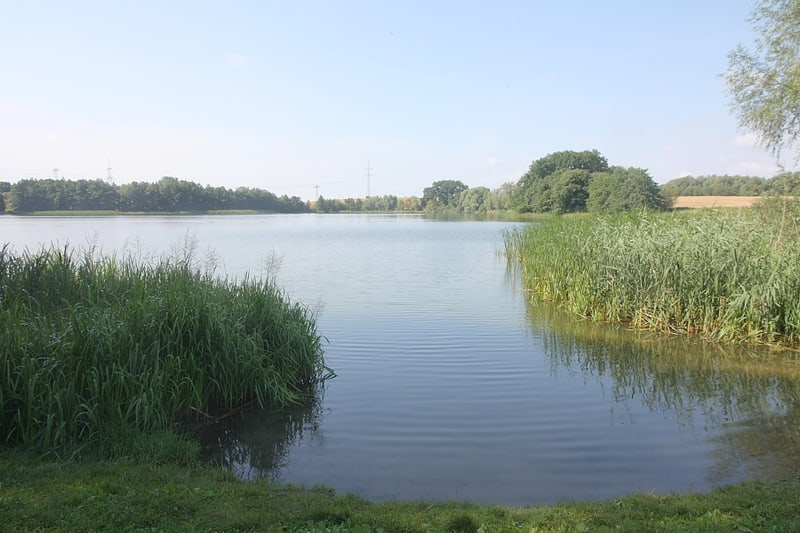
Lake in Germany. Sildemower See is a lake in the Rostock district in Mecklenburg-Vorpommern, Germany. At an elevation of 13.2 m, its surface area is 0.121 km².[19]
Inselsee
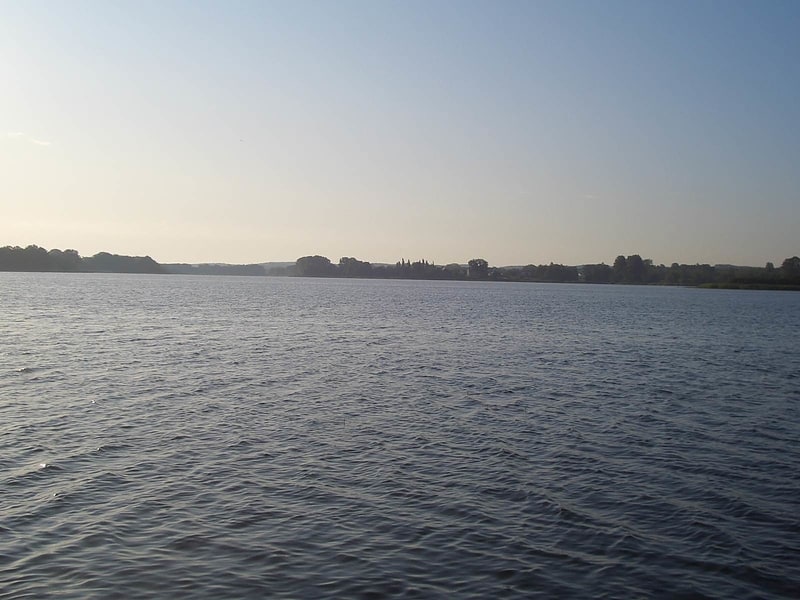
Lake in Germany. Inselsee is a lake in the Rostock district in Mecklenburg-Vorpommern, Germany. At an elevation of 11.4 m, its surface area is 4.58 km². The lake is divided into two parts by a small 60 ha island „Schöninsel“. While the northern part of the lake is relatively flat, the average depth of the southern part is up to 6 m. The island is connected to the mainland by a bridge.
The lake is located in the town limits of Güstrow, south of the city center.
On the southern shore of Inselsee, the studio of Ernst Barlach, a German sculptor, is located. It was used by Barlach in the 1930s and currently functions as a museum.[20]
Teterower See
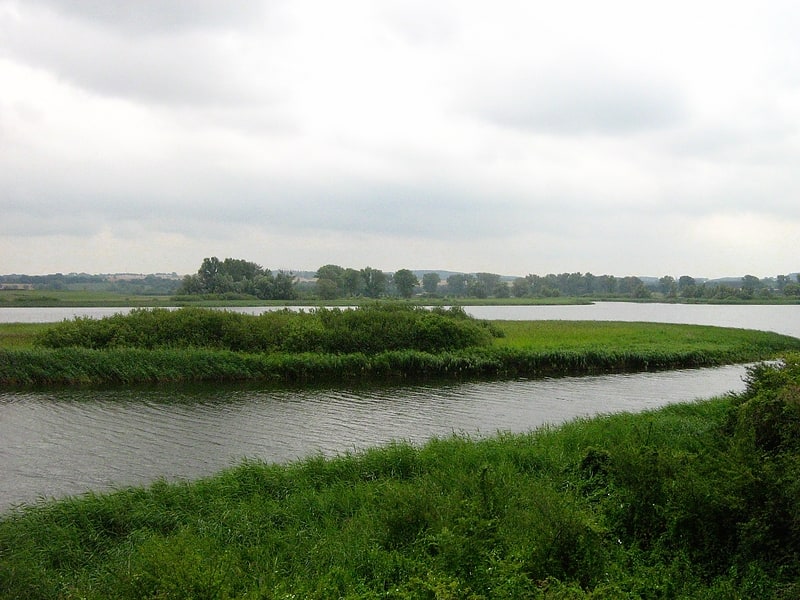
Lake in Germany. The Teterower See is a lake within the Mecklenburgische Schweiz und Kummerower See Nature Park in Mecklenburg-Vorpommern, Germany. It is situated immediately to the north-east of the town of Teterow, and is about 200 kilometres north of Berlin.
The lake is approximately 3.3 kilometres (2.1 mi) long and 1.9 kilometres (1.2 mi) wide, with an average depth of 4 metres (13 ft) and a maximum depth of 10.7 metres (35 ft). It has an area of 3.36 square kilometres (1.30 sq mi), and is only 2.4 metres (7 ft 10 in) above sea level. The southern shoreline is heavily indented, and includes the Sauerwerder peninsular and the Burgwallinsel island.
Burgwallinsel is accessed by the Teterower See Ferry, a cable ferry. Also operating on the lake is the historic cruise ship Regulus, originally built in 1910 and first used on the Teterower See in 1930. During the Second World War it was sunk. In 1999, the wreck was found in the lake and salvaged. It was returned to use in 2001.[21]
Schwarzer See
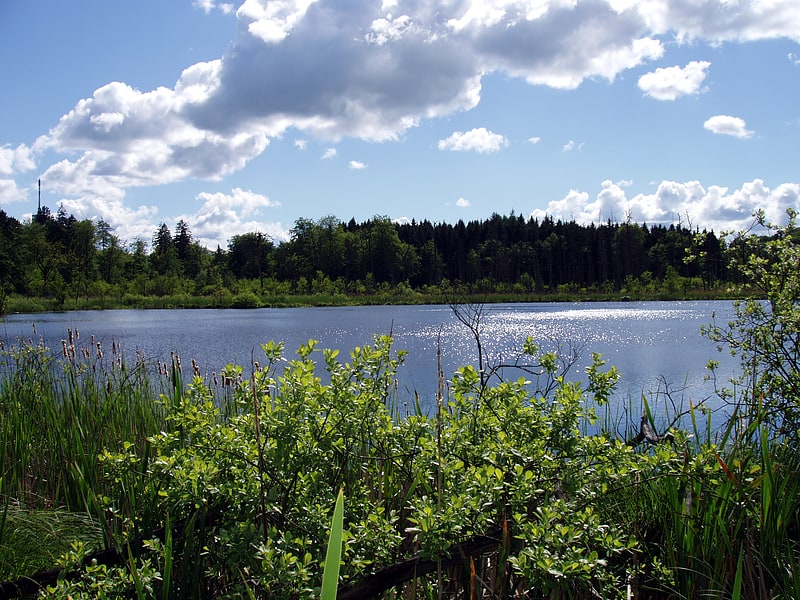
Lake in Germany. The Schwarze See is a lake in Schlemmin, Rostock, Mecklenburg-Vorpommern, Germany. At an elevation of 108.3 m, its surface area is 0.21 km².[22]
University of Rostock
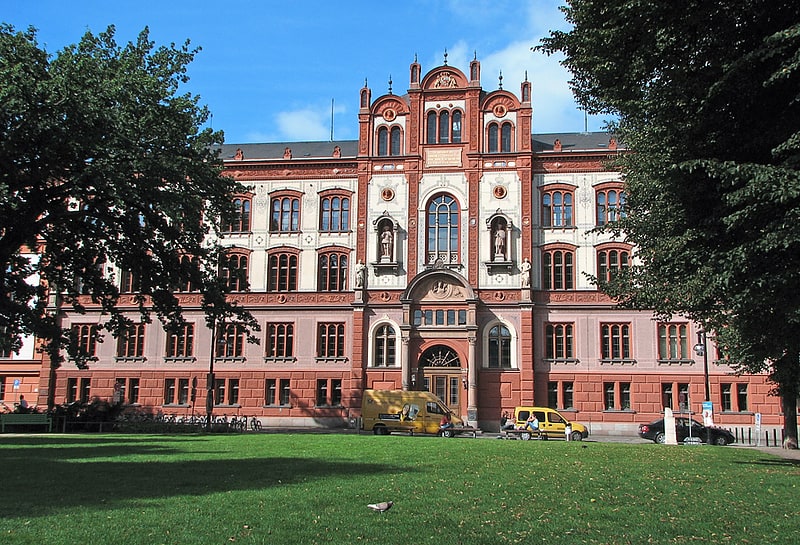
Also known as: Universität Rostock
Public university in Rostock, Germany. The University of Rostock is a public university located in Rostock, Mecklenburg-Vorpommern, Germany. Founded in 1419, it is the third-oldest university in Germany. It is the oldest university in continental northern Europe and the Baltic Sea area, and 8th oldest in Central Europe. It was the 5th university established in the Holy Roman Empire.
The university has been associated with five Nobel laureates: Albrecht Kossel, Karl von Frisch, Otto Stern, Pascual Jordan, and Walter H. Schottky. It is a member of the European University Association. The language of instruction is usually German and English for some postgraduate studies.[23]
Address: Universitaetsplatz 1, 18055 Rostock (Ortsamt 6)
Satower See
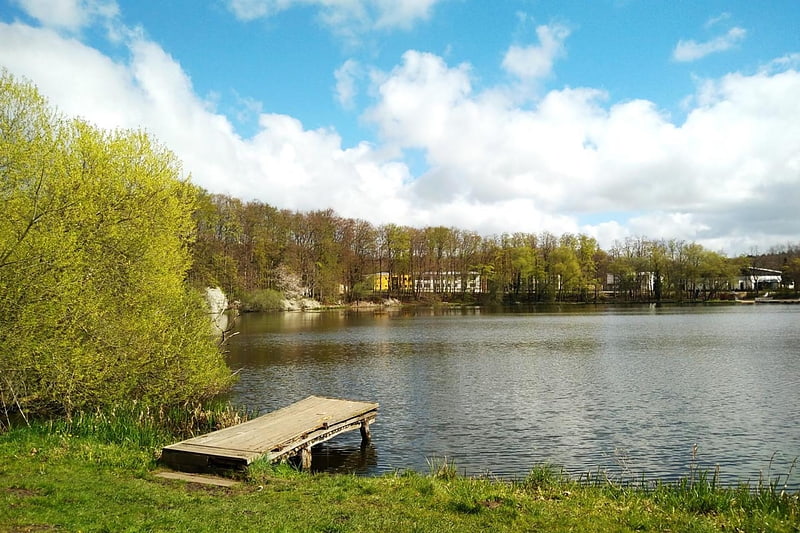
Lake in Germany. Satower See is a lake in the Rostock district in Mecklenburg-Vorpommern, Germany. At an elevation of 30.1 m, its surface area is 0.068 km2.[24]
Frieden
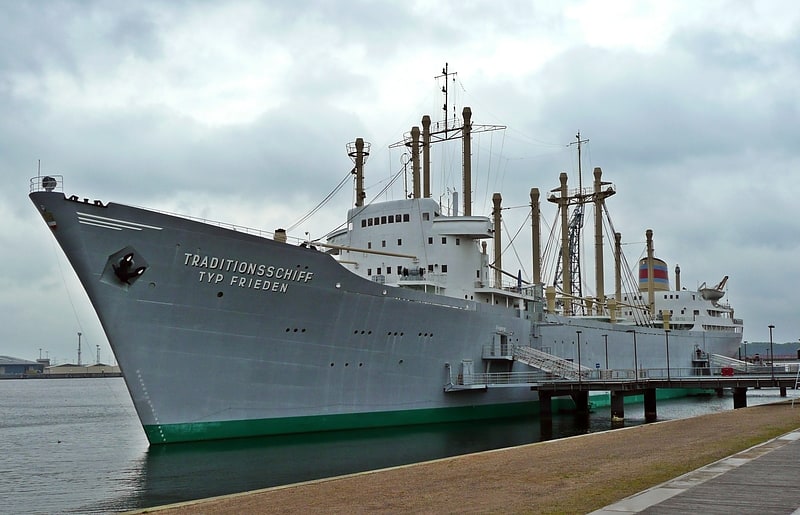
Vessel. The Frieden is the former German motor vessel Dresden operated by the VEB Deutsche Seereederei Rostock. Since 1970 it has been used as a museum ship.
The Dresden was built in 1956/57 at the Warnow Shipyard. It was the fifth Type IV ship in the first batch of 10,000 tonne piece-goods freighters that were built in East Germany's shipyards after the Second World War. Because the first ship of this series was christened Frieden (commissioned in June 1957), the other ships of this series of 15 new vessels were classed as Frieden type merchant ships.
On 27 July 1958 the ship was handed over to the Deutsche Seereederei shipping line and it operated until 1969 on scheduled services to East Asia, Indonesia, Africa, India and Latin America.
After some serious defects that were found in the engine room that would have resulted in excessive repair costs, the ship was decommissioned in 1969 and opened on 13 June 1970 as the "Rostock Shipbuilding Museum" (Schiffbaumuseum Rostock). Part of the ship also acted as a youth hostel for a time.
Today it is part of the Rostock Shipbuilding and Shipping Museum (Rostocker Schiffbau- und Schifffahrtsmuseum) in the IGA Park and contains comprehensive exhibitions of shipbuilding history. Topics include Shipbuilding in East Germany, Shipyard Operations, the History of Maritime Radio Communications and Navigation. In addition, there is a collection of various types of ship engine. Many areas of the ship have been preserved in their original state (the engine room, bridge, radio station, ship's hospital and crew cabins) and give an impression of life on a merchant ship in the 1950/60s.
The Rostock City Harbour Museum Ship action group (Traditionsschiff Stadthafen Rostock) is advocating moving the shipyard and shipping museum to a central and easily accessible site in the centre of Rostock. Low visitor numbers have been cited as the reason for this initiative.[25]
Address: Schmarl Dorf 40, Rostock (Ortsamt 4)
Heimatmuseum Warnemünde

The Warnemünde Museum of Local History is a folklore museum in the Warnemünde district of the Hanseatic city of Rostock.
Warnemünde

City in Germany. Warnemünde is a seaside resort and a district of the city of Rostock in Mecklenburg, Germany. It is located on the Baltic Sea and, as the name implies, at the estuary of the river Warnow. Warnemünde is one of the world's busiest cruise ports.[26]
Dokumentations- und Gedenkstätte für Opfer deutscher Dikaturen BStU Rostock
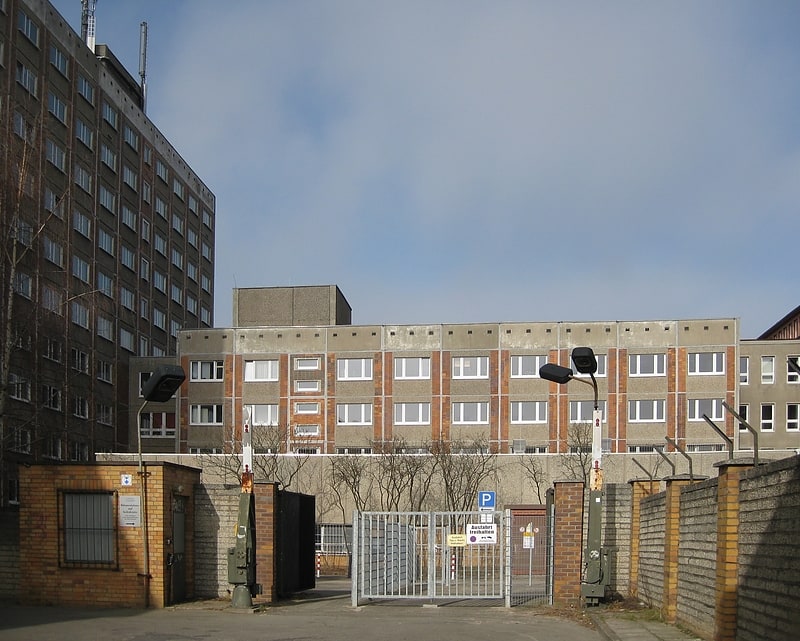
The documentation and memorial site in the former remand prison of the district administration of the Stasi in Rostock focuses on the work of the Ministry for State Security of the GDR and commemorates its victims. It is one of the best preserved pre-trial detention facilities of the MfS. The DuG is embedded in the Documentation Center of the State of Mecklenburg-Western Pomerania for the Victims of Dictatorships in Germany and was operated until August 2017 by the Rostock branch of the Federal Commissioner for Stasi Records in cooperation with the University of Rostock. Between 2017 and 2021, the DuG was closed for renovation. In 2021, the State Center for Political Education of Mecklenburg-Western Pomerania took over the sponsorship.
Address: 34b Hermannstraße, Rostock (Ortsamt 6)
Bützow Castle
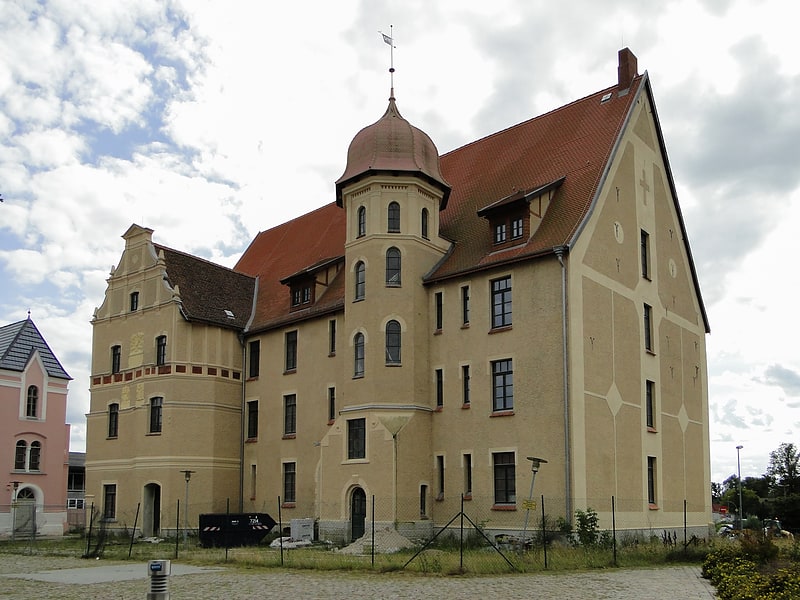
Also known as: Schloss Bützow
Castle in Bützow, Germany. Bützow Castle is a castle in Bützow, Germany.
The castle is built on the foundations of a Slav fortress, and served as the residential castle of the bishops of Schwerin. It was transformed into a Renaissance castle by Duke Ulrich of Mecklenburg in 1556.[27]
Address: Schlosspl. 2, 18246 Bützow
Steintor

The Stone Gate in its present form is a gate built in 1574 to 1577 in the Renaissance architectural style in the south of the historic Rostock city fortifications. It replaced the older gate, which was sanded in 1566. Along with the Kröpeliner Tor, the Petritor and the Mühlentor, the Steintor was one of the four main gates of the city of Rostock.
Address: 1 Steinstraße, Rostock (Ortsamt 6)
Bützower See
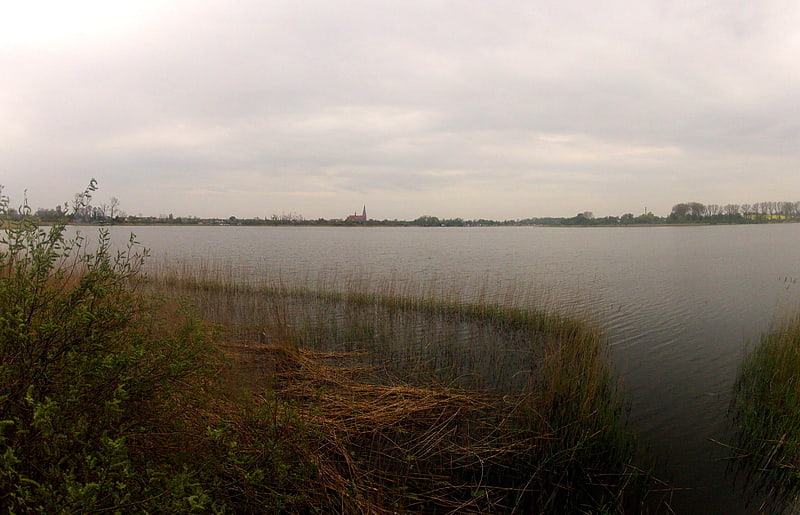
Lake in Germany. Bützower See is a lake in Mecklenburg-Vorpommern, Germany. At an elevation of 0.3 m, its surface area is 0.98 km².[28]
Kühlungsborn
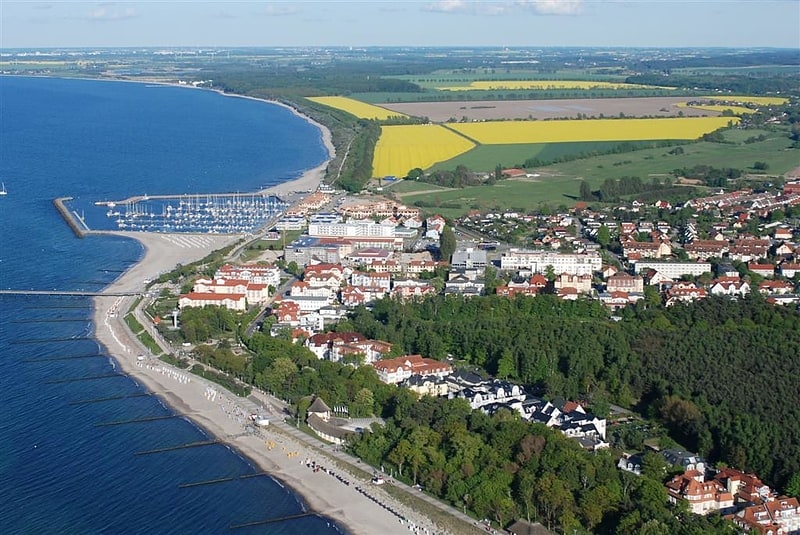
Town in Germany. Kühlungsborn is a Seebad town in the Rostock district, in Mecklenburg-Vorpommern, Germany. It is situated on the Baltic Sea coast, 11 km northwest of Bad Doberan, and 25 km northwest of Rostock.
The town has an elongate beach and promenade, many hotels in typical German spa town architecture and a marina. It is the largest seaside spa town in Mecklenburg.
Kühlungsborn is a place with long spa traditions. It was one of the first seaside resorts to be founded in Germany, dating back to the 1860s. While the bicycle is a popular way of transport, the Molli steam railway is an historic tourist attraction that also allows exploration the area. In summer times many people rent one of the traditional Strandkorb on the beach, a covered chair protecting one from wind and sun.[29]
Langsee
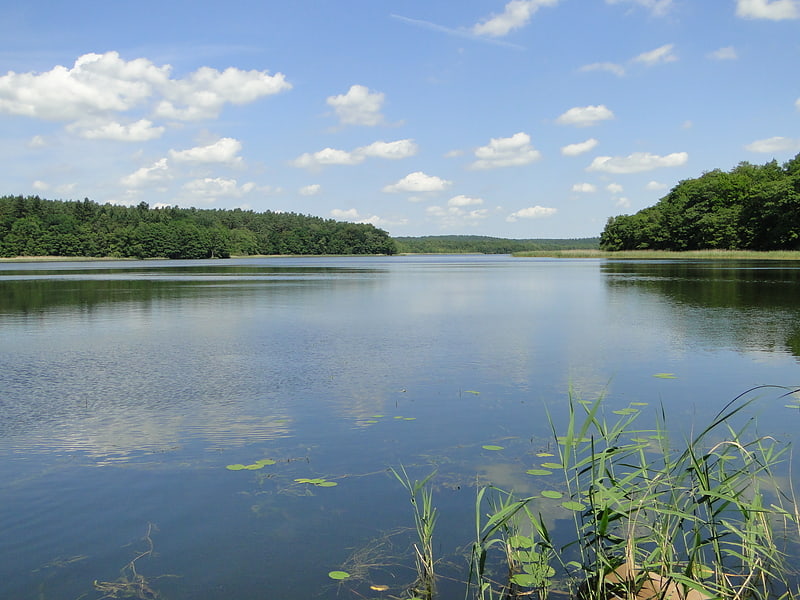
Lake in Germany. Langsee is a lake in the Rostock district in Mecklenburg-Vorpommern, Germany. At an elevation of 50.1 m, its surface area is 0.82 km².[30]